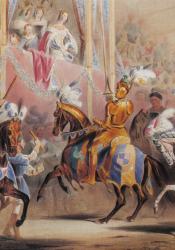The Eglinton Tournament
Defined by Oxford Dictionary as “the inferred responsibility of privileged people to act with generosity and nobility toward those less privileged.” Naturally, many of us would immediately think of class, and how it was the “responsibility” of the nobles to “act with generosity and nobility” towards the lower classes. But it also happens to apply to the inferred responsibility that men have to women, adults towards children, and, of course, anyone “inferior.” The idea of noblesse oblige was based on the idea of “medieval chivalry,” which had become an increasingly popular image triggered when Kenelm Digby published The Broad Stone of Honour in 1822 (Dryden 17-8). This idea became almost perfectly exemplified in Earl Archibald William Montgomerie of Eglinton’s intention when hosting the Eglinton tournament in 1839, in an attempt to revive medieval chivalry to a more common way of life.
More specifically stated, Montgomerie’s intention was desired to be a demonstration of romanticism, which was an age that preferred a more medieval approach than a classical one. This meant returning certain ideas such as that of the chivalry of a gentleman, which embodied “bravery, loyalty, courtesy, modesty, purity and honour and endowed with a sense of noblesse oblige towards women, children and social inferiors (in Mangan and Walvin 113)” (Dryden 18). And while many called it an “absolute fiasco,” it was also one that “emanated from the minds...uncomfortable with industrial, urban England” (Dryden 18 ; Tyrell 2010). Whether it was an event that was from the minds of those who were uncomfortable with urbanization or not, it was clear that the deficiencies of the event did nothing to discourage the idea that chivalry applied to men of all classes, much less to discourage noblesse oblige. One of the other characteristics of a chivalrous gentleman was that he was polite and deferential to women of every class, which bridges yet another divide between classes, especially when taking into consideration that Queen Victoria of England was the embodiment of a woman worthy of a knight’s devotion. Given, she was the queen and it was part of her job to embody a woman worthy of a knight’s devotion, it became even more clear that women of every class should follow her example. The only drawback of being chivalrous is that it only applies to and for those who are devout Christians. Anyone else would either be too barbaric or otherwise unworthy of receiving any form of noblesse oblige.
Works Cited
Dryden, L. Joseph Conrad and the Imperial Romance. London-United Kingdom, United Kingdom, Palgrave Macmillan, 1999.
Tyrrell, Alex. “A Card King? The Earl of Eglinton and the Viceroyalty of Ireland.” The Historian, vol. 72, no. 4, 2010, pp. 866–887. JSTOR, www.jstor.org/stable/24454753. Accessed 7 Oct. 2020.

